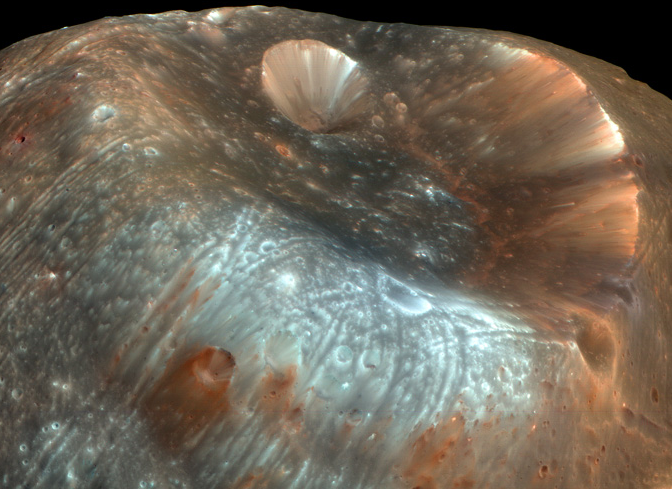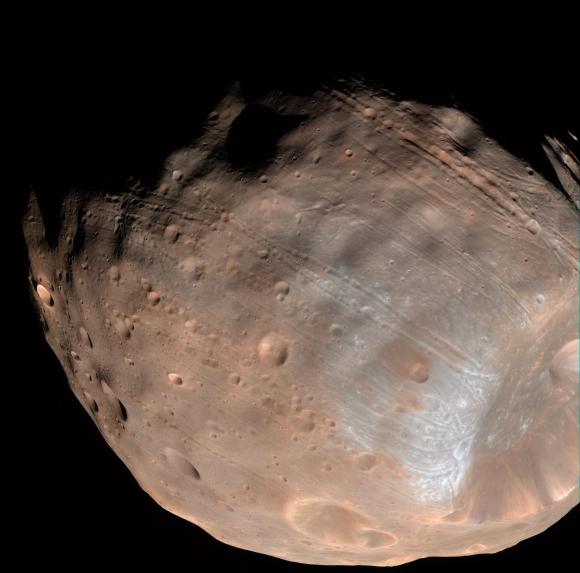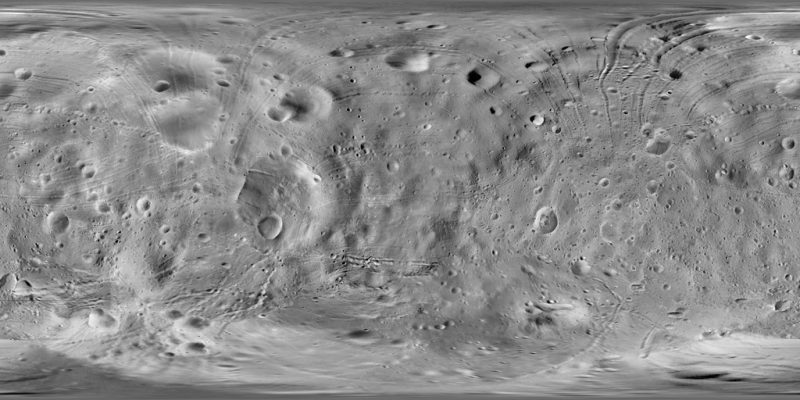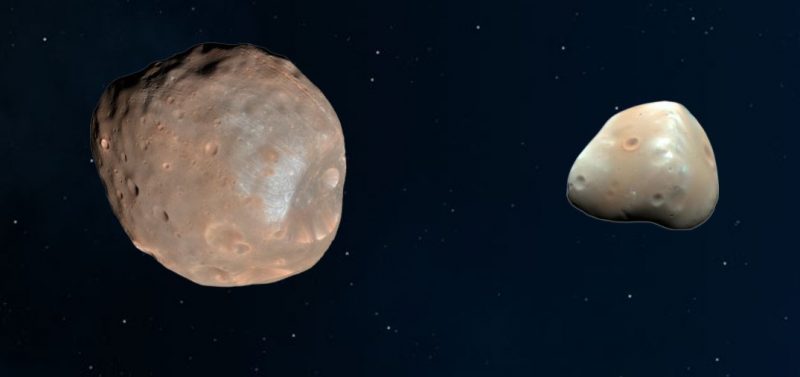

Color-enhanced image of the large crater Stickney on the Martian moon Phobos. The crater is 5.6 miles (9 km) in diameter, so it takes up a substantial proportion of Phobos’ surface. The impact almost destroyed the small moon! Notice the smaller crater within Stickney, about 1.2 miles (2 km) in diameter, resulting from a later impact. Image via HiRISE/ MRO/ LPL (U. Arizona)/ NASA.
August 17, 1877. It was on this date that American astronomer Asaph Hall discovered Phobos, the larger of Mars’ two small moons. He also found the other moon, which we call Deimos, later that same year. Both of these moons are potato-shaped. They look more like asteroids than they do Earth’s much-larger companion moon. It’s possible that – millions of years from now – Phobos will shatter and form a ring around Mars. Or it’s possible that the material in this moon alternates between becoming a planetary ring and clumping up again to form a moon. More about ring theories of Phobos below.
Phobos and Deimos – whose names mean Fear and Terror – were named for the horses that pulled the chariot of the Greek war god Ares, who was the counterpart to the Roman war god Mars. They’re the only moons ever found orbiting the red planet.
Although it is the larger moon, Phobos is tiny, with a mean diameter of only about 14 miles (22.2 km). It’s more than seven times as massive as Deimos, whose mean diameter is about 7.7 miles (12.4 km). For these moons, we’re speaking in terms of a mean diameter because both moons are oblong in shape and not spherical. In contrast, Earth’s moon is nearly round, since it is large enough for its gravity to pull it into a spherical shape. It’s also much larger, 2,159 miles (3,475 km) in diameter. Both Phobos and Deimos have very weak gravity since they are so tiny, and so it is not nearly strong enough for those moons to be round.
It wasn’t until 1971 and 1972 that scientists got their first close-up look at Phobos, during Mariner 9’s mission to Mars. Its oblong surface was found to be pitted by many small craters, just like asteroids. But one large crater stood out, later called Stickney Crater, after Chloe Angeline Stickney Hall, wife of Phobos’ discoverer. It looks like a giant hole in one end of the moon, and the asteroid or other rocky body that created it was almost big enough to have shattered the moon completely, but not quite. Phobos barely survived the impact.

Phobos and its large crater, named Stickney, as seen by Viking I. The spacecraft acquired this image in June 1977, 100 years after the discovery of Phobos. Image via NASA.

A closer view of the grooves on Phobos. Image via NASA/ JPL-Caltech/ University of Arizona.

Global map of Phobos, obtained by the Viking orbiter. Image via Astrogeology Science Center/ Planetary Data System/ Phil Stooke.
Was Phobos once a ring? Will it be again? Phobos also has long, shallow grooves running across its surface, radiating away from Stickney. Many planetary scientists believe that they are early signs of eventual structural failure in the moon. They say it’s possible that – some 50 million years from now – Phobos will break apart, becoming a ring around Mars.
A study in 2018 study suggested that rolling boulders created the grooves as they were sprayed across the surface of Phobos during the impact that created the large Stickney crater. As Ken Ramsley, a planetary science researcher at Brown University who led the work, explained:
These grooves are a distinctive feature of Phobos, and how they formed has been debated by planetary scientists for 40 years. We think this study is another step toward zeroing in on an explanation.
In 2017, a new theory by Purdue University scientists suggested that Mars’ moon Phobos might not only break apart, and form a ring around the planet, but also that this ring formation had happened before. David Minton, a professor, and Andrew Hesselbrock, a doctoral student, both at Purdue, developed a computer model showing that debris that was pushed into space from an asteroid or other body slamming into Mars – some 4.3 billion years ago – would now alternate between becoming a planetary ring and clumping up again to form the moon Phobos. Read more about that theory here.

Size and visual comparison of Phobos (left) and Deimos (right). Image via NASA.

Artist’s concept of rings around Mars. Image via Kevin Gill on Flickr/ CC by 2.0.
Another study, from scientists at Purdue and the SETI Institute in June 2020, also came to the conclusion that Mars used to have a ring, or series of rings, based on studies of Deimos. The findings of that study would also help to explain why the smaller moon Deimos has an unusually tilted orbit, while Phobos does not. Deimos’ orbit is inclined about 2 degrees relative to Mars’ equator.
How does this relate to Phobos? According to the researchers:
These orbital resonances are picky but predictable … We can tell that only an outward-moving moon could have strongly affected Deimos, which means that Mars must have had a ring pushing the inner moon outward. Cuk and collaborators deduce that this moon may have been 20 times as massive as Phobos, and may have been its ‘grandparent’ existing just over 3 billion years ago … [that] was followed by two more ring-moon cycles, with the latest moon being Phobos.
So basically, there used to be a moon about 20 times as massive as Phobos that was being pushed outward by the ring(s). At least two times since then, that moon broke apart and then formed a new ring, before the material coalesced together again to form a new moon. Phobos is now that current moon, and, the scientists say, will eventually break apart to form a new ring, continuing the cycle.
Scientists also now know that Phobos is much younger than Deimos – perhaps only 200 million years old – which would fit the moon/ring scenario. The Phobos wee see today is simply a younger and smaller version of its original self.
Asaph Hall probably never imagined the idea of Phobos breaking apart and forming a ring around Mars. And he couldn’t possibly have imagined the video above, which was acquired by NASA’s Mars rover Curiosity on August 1, 2013. The rover had been taking a series of shots of the sky above, from Mars’ surface. This video shows both moons, Phobos and Deimos, as you might see them while standing on the surface of Mars. You can clearly see some of the large craters on Phobos in these images.
This was the first time ever that images taken from Mars’ surface caught one moon eclipsing the other. The moons have also sometimes been seen passing in front of the sun, although they don’t block it out completely like a total eclipse on Earth.
Bottom line: On August 17, 1877, American astronomer Asaph Hall discovered Phobos, the larger of the two Martian moons. He also discovered Deimos later that year.
Source:
https://earthsky.org/space/this-date-in-science-asaph-hall-discovers-a-moon-for-mars